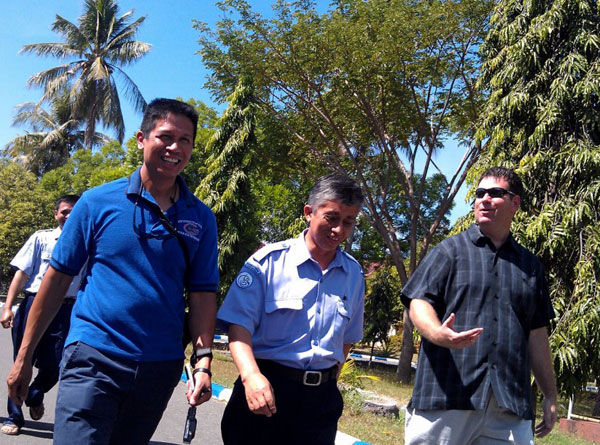BANGGAI RESCUE PROJECT
Science Team Starts Work in Indonesia

The science team gathering in Bali: Fish veterinarian Dr. Roy Yanong, DVM, left, and
Dr. Tom Waltzek, VMD, PhD, right, an aquatic veterinary pathologist, both from
the University of Florida, tour a research facility in Bali this week with
a new Indonesian colleague, center. Images by Ret Talbot.
International team tries to unravel the conundrum of Pterapogon kauderni
By RET TALBOT
June 26, 2012 Luwuk, Sulawesi, Indonesia - Banggai Rescue is now in full swing, and we’re excited to share our adventures and investigations with you! As you know, Matthew Pedersen is hard at work in the new fish room in Minnesota, Karen Talbot is working on scientific illustrations in California, the U.S.-based scientific team is now on the ground and collaborating with their Indonesian counterparts in Bali, and James Lawrence, in Vermont, is keeping us all moving in the right direction toward our book publication deadline.
The U.S. Science Team is here, including Dr. Matthew L. Wittenrich, Ph.D.; Dr. Roy Yanong, V.M.D: Dr. Thomas Waltzek, V.M.D., Ph.D., all from the University of Florida’s Tropical Aquaculture Laboratory. They have teamed up with Indonesian marine biologists, including Gayatri Reksodihardjo-Lilley, Dr. Ketut Mahardika, Ph.D.; and Yunaldi Yahya, M.Sc.
Right: Luwuk Harbour, departure point to the Banggai Islands and a site of reported release of Pterapogon kauderni outside their normal range.
Unknowns Galore
The team in Indonesia is learning that, as expected, there are more unknowns about the Banggai Cardinalfish than hard facts. Sure, we know it is a beguiling fish with a set of fascinating biological characteristics. We believe it is a species endemic to a very limited area (the Banggai Archipelago to the east of Central Sulawesi, Indonesia) but introduced populations are on the rise.
We know that since 2003-04, there has been a sharp increase in mortality of Banggai Cardinalfish in public aquaria, aquaculture facilities and in the marine ornamental trade the world over. We know much of this mortality is directly related to a relatively indiscriminate and alarming virus with repercussions that could extend far beyond marine ornamentals with potential impacts to food and recreational fisheries.
• But where is the virus originating? How can healthy Banggai Cardinalfish broodstock be reliably obtained for home and commercial aquaculture and the marine aquarium trade? Is the virus a threat to wild populations?
• What is the real impact of the trade on endemic populations, host ecosystems, and local fishers and fisher communities?
• What are the potential impacts of what we are learning on Indonesia‚Äôs marine aquarium trade, and how is the Banggai cardinalfish emblematic of trade-wide issues that require greater transparency and wider discussion?
These questions are ones that keep team members up late into the night discussing, debating and hypothesising, and with so many unique backgrounds and skill sets in play, these discussions are yielding truly exciting, interdisciplinary and novel approaches to the larger discussion about the Banggai Cardinalfish.
In terms of nuts and bolts, the U.S.-based scientists arrived in Indonesia on Friday and Saturday, making the Indonesian expeditionary team complete. After meeting with Banggai Rescue’s in-country sponsor, Gayatri Lilley of Yayasan Alam Indonesia Lestari (Indonesian Nature Foundation or LINI) on Saturday morning, we headed to West Bali and then Java and the town of Banyuwangi on Selat Bali (Bali Straits), where several marine aquarium trade export facilities deal regularly with Banggai Cardinalfish and where there are reports of introduced Pterapogon kaudernipopulations living in the wild.
Wild-caught Banggai Cardinalfish in a holding facility in Bali, Indonesia.
On Monday morning, we were hosted by the Gondol Research Institute for Mariculture in North Bali (GRIM), where one of the Indonesian scientists who will be working closely with the U.S.-based scientists in the Banggai Islands is based. The entire team was very impressed with the facility and the scientists who work there (more to come on our visit), and we are looking forward to collaborating fully with them. On Tuesday, the US-based scientists, using information provided by our Indonesian counterparts, set out to observe more introduced populations in Bali before briefly returning to the south and tomorrow’s flight to the Banggai Islands.
We will try to post another update before leaving for the Banggai Archipelago, but from here on out, Internet connection may be spotty at best. Rest assured we will be documenting all our activities, and we will update you when we are able. Thank you again for your interest and support of this important project. While we may be a small group made up of passionate scientists, fish breeders, aquarists, a journalist, an artist, and a publisher, we very much feel as if you all our part of the Team! Stay tuned.¶